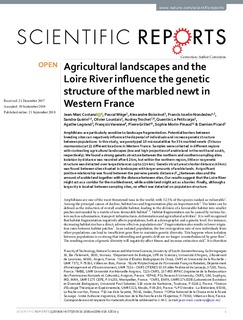| dc.contributor.author | Costanzi, Jean-Marc | |
| dc.contributor.author | Pascal, Mege | |
| dc.contributor.author | Alexandre, Boissinot | |
| dc.contributor.author | Francis, Isselin-Nondedeu | |
| dc.contributor.author | Sandra, Guerin | |
| dc.contributor.author | Olivier, Lourdais | |
| dc.contributor.author | Audrey, Trochet | |
| dc.contributor.author | Quentin, Le Petitcorps | |
| dc.contributor.author | Agathe, Legrand | |
| dc.contributor.author | Francois, Varenne | |
| dc.contributor.author | Pierre, Grillet | |
| dc.contributor.author | Sophie, Morin-Pinaud | |
| dc.contributor.author | Damien, Picard | |
| dc.date.accessioned | 2019-01-22T12:09:50Z | |
| dc.date.available | 2019-01-22T12:09:50Z | |
| dc.date.created | 2018-11-27T15:19:07Z | |
| dc.date.issued | 2018 | |
| dc.identifier.citation | Scientific Reports. 2018, 8 (1). | nb_NO |
| dc.identifier.issn | 2045-2322 | |
| dc.identifier.uri | http://hdl.handle.net/11250/2581763 | |
| dc.description | This article is licensed under a Creative Commons Attribution 4.0 International License, which permits use, sharing, adaptation, distribution and reproduction in any medium or format, as long as you give appropriate credit to the original author(s) and the source, provide a link to the Creative Commons license, and indicate if changes were made. | nb_NO |
| dc.description.abstract | Amphibians are particularly sensitive to landscape fragmentation. Potential barriers between breeding sites can negatively infuence the dispersal of individuals and increase genetic structure between populations. In this study, we genotyped 10 microsatellites for 334 marbled newts (Triturus marmoratus) at 11 diferent locations in Western France. Samples were collected in diferent regions with contrasting agricultural landscapes (low and high proportion of arable land in the north and south, respectively). We found a strong genetic structure between the northern and southern sampling sites. Isolation by distance was recorded after 62km, but within the northern region, little or no genetic structure was detected over large distances (up to 114km). Genetic structure at shorter distance (43km) was found between sites situated in landscapes with larger amounts of arable lands. A signifcant positive relationship was found between the pairwise genetic distance (Fst) between sites and the amount of arable land together with the distance between sites. Our results suggest that the Loire River might act as a corridor for the marbled newt, while arable land might act as a barrier. Finally, although a large city is located between sampling sites, no efect was detected on population structure. | nb_NO |
| dc.language.iso | eng | nb_NO |
| dc.rights | Navngivelse 4.0 Internasjonal | * |
| dc.rights.uri | http://creativecommons.org/licenses/by/4.0/deed.no | * |
| dc.title | Agricultural landscapes and the Loire River influence the genetic structure of the marbled newt in Western France | nb_NO |
| dc.type | Journal article | nb_NO |
| dc.type | Peer reviewed | nb_NO |
| dc.description.version | publishedVersion | nb_NO |
| dc.rights.holder | (c) 2018 The Authors | nb_NO |
| dc.source.pagenumber | 12 | nb_NO |
| dc.source.volume | 8 | nb_NO |
| dc.source.journal | Scientific Reports | nb_NO |
| dc.source.issue | 1 | nb_NO |
| dc.identifier.doi | 10.1038/s41598-018-32514-y | |
| dc.identifier.cristin | 1635903 | |
| cristin.unitcode | 222,58,1,0 | |
| cristin.unitname | Institutt for natur, helse og miljø | |
| cristin.ispublished | true | |
| cristin.fulltext | original | |
| cristin.qualitycode | 1 | |

